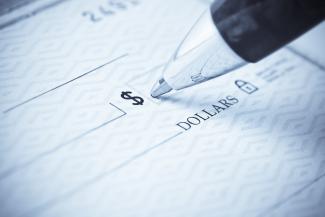
Your Guide To Prevent Check Fraud
Your Guide To Prevent Check Fraud
Checks are one of the oldest methods of making payments. They're still among the first items you'll receive when you create a checking account. Though digital banking has mostly replaced checks in recent years, they remain a popular means of payment—and one that is especially prone to fraud.
Check fraud is a criminal offense involving the unlawful alteration, forging, or theft of checks intending to withdraw money from a bank account. Despite rapid technological improvements and the popularity of digital payment methods, one of the most striking increases in financial fraud over the last several years has come from a conventional tactic: check fraud.
There are various sorts of check fraud. However, fraudsters frequently utilize stolen or counterfeit checks to defraud or manipulate the account holder or financial institution. This could include stealing blank checks, intercepting previously written checks, or making fraudulent checks to deceive people.
Businesses not taking steps to screen for fraudulent checks may be held accountable. Regardless of responsibility, bogus check scams can cause a loss of revenue or public faith.
Another popular approach is check washing. Crooks steal checks from mailboxes or garbage cans (a practice known as dumpster diving) and then use chemicals to remove the ink from them. They change the amount and payee and use the altered check to steal money.
Check fraud can also occur by using stolen checks. Criminals will steal blank checks from individuals or businesses and use them to make illicit purchases or withdraw funds.
Common Types of Check Fraud
Paperhanging
Account holders use paper hanging to write checks from a closed or overdrawn account. They could do this to take advantage of float time (when a cheque is drawn and when monies are moved from the account) or avoid payment entirely. Regardless, businesses need help with a faulty check.
Forgery
Unauthorized individuals sign a check in another person's name (known as identity theft). Fraudulent misrepresentation of an account holder might result in unauthorized withdrawals from the victim's account.
Employers and groups such as the American Bankers Association frequently provide bank tellers with training on how to spot fake checks.
Check Kiting
Checkkiting refers to numerous types of fraud that involve writing bogus checks and using several bank accounts. In one scenario, someone may write a bad check from Bank A and temporarily cover the amount by writing another bad check from Bank B and depositing it into Bank A. This cycle may continue until enough money is available to cover the amount. Alternatively, the individual may utilize this system to make credit card payments before withdrawing cash or using the card.
Check alteration
Check modification is generally done in conjunction with mail theft. Thieves intercept cheques in recipients' mailboxes and modify them to change the payee or the check amount.
Check-washing fraud occurs when crooks use nail polish remover to wipe details from a check. They can then fill it out as they see appropriate, or upload a screenshot of the "washed" check to the web, or send it to other scammers so they can purchase, sell, and trade counterfeit checks.
Counterfeiting
Counterfeiters use high-quality paper and modern printing techniques to create copied or phony checks.
These fake checks are frequently indistinguishable from authentic ones to the untrained eye and can be used to conduct unlawful transactions or fraudulent ATM check deposits.
Money order scams
Some types of fraud rely on money orders. In this scenario, the fraudster hands the victim a money order. They then request that the individual receiving the money order write them a check in return, sometimes promising to pay them extra. Of course, the money order is fraudulent, and the victim loses all the money from their check.
How To Prevent Check Fraud
Secure your checks
Personal checks and financial records should be stored in a safe, locked area with only authorized access. If you receive checks via a post office P.O. box, be sure the location is secure and only authorized staff have access.
Prevent check-washing and alteration.
Many banks and credit unions use watermarks and other security elements to make tampering with someone else's cheque difficult. These features also make it easier to detect when checks have been manipulated, discouraging scammers from attempting to commit fraud.
Use your bank to send checks instead of do it yourself.
Consider if your bank provides a service if you need to pay for something with a check. Using this service means that the payment information will be printed on a check, making it more difficult for a scammer to erase the data than a handwritten personal check.
Detect fake checks
Keep in mind that modern scammers are incredibly cunning. A counterfeit check may appear to be authentic. If you need to contact the bank to confirm the check is genuine, always use the phone number or contact information provided on the bank's website, as the bogus check may contain a false phone number or address.
Stay wary of third-party checks.
What happens if someone tries to pay with a third-party check, like a payroll or government check? It's probable that the checks were taken. While there is no legislation prohibiting (legal) third-party checks, accepting them can jeopardize your firm. It might be advisable to have a clear payment policy that prohibits third-party checks.
In conclusion, check fraud is a severe crime that lead to substantial financial damages for individuals and corporations. Understanding the various strategies used by fraudsters and employing preventative and detection methods will help you protect yourself and your finances.
